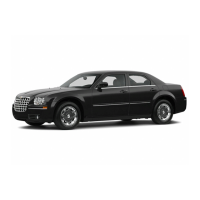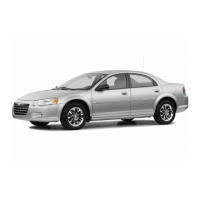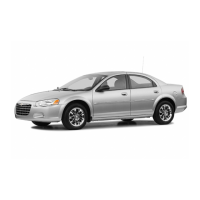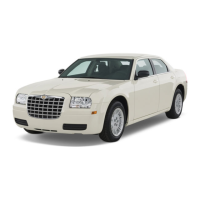CHECKING ENGINE OIL PRESSURE
Check oil pressure using gauge at oil pressure
switch location. Oil pressure should be 34 kPa (5 psi)
at idle or 205 to 724 kPa (30 to 105 psi.) at 3000
RPM.
(1) Remove pressure sending unit. The pressure
sending unit is located on the left front of engine
near the oil filter.
(2) Install oil pressure gauge.
CAUTION: If oil pressure is 0 at idle, Do Not Run
engine at 3000 RPM.
(3) Warm engine to normal operating temperature.
VALVE SPRING TESTING
VALVE SPRING IDENTIFICATION
The valve springs are of two different lengths and
are wound in different directions. The valve springs
are color coded: the intake spring has a right hand
coil direction with orange dye on the top coils and the
exhaust spring has a left hand coil direction with yel-
low dye on the top coils (Fig. 12).
TESTING VALVE SPRINGS
When valves have been removed for inspection,
reconditioning or replacement, valve springs should
be tested (Fig. 13). As an example; the compression
length of the spring to be tested is 38.00 mm (1.496
in.). Turn table of Tool C-647 until surface is in line
with the 38.00 mm (1.496 inches.) mark on the
threaded stud and the zero mark on the front. Place
spring over stud on the table and lift compressing
lever to set tone device. Pull on torque wrench until
ping is heard. Take reading on torque wrench at this
instant. Multiply this reading by two. This will give
the spring load at test length. Fractional measure-
ments are indicated on the table for finer adjust-
ments. Refer to Specifications Section to obtain
specified height and allowable tensions. Replace
springs that do not meet specifications.
INTAKE MANIFOLD LEAKAGE DIAGNOSIS
An intake manifold air leak is characterized by
lower than normal manifold vacuum. Also, one or
more cylinders may not be functioning.
WARNING: USE EXTREME CAUTION WHEN THE
ENGINE IS OPERATING. DO NOT STAND IN A
DIRECT LINE WITH THE FAN. DO NOT PUT YOUR
HANDS NEAR THE PULLEYS, BELTS OR THE FAN.
DO NOT WEAR LOOSE CLOTHING.
(1) Start the engine.
(2) Spray a small stream of water (Spray Bottle) at
the suspected leak area.
(3) If engine RPM’S change, the area of the sus-
pected leak has been found.
(4) Repair as required.
CYLINDER COMPRESSION PRESSURE TEST
The results of a cylinder compression pressure test
can be utilized to diagnose several engine malfunc-
tions.
Ensure the battery is completely charged and the
engine starter motor is in good operating condition.
Otherwise the indicated compression pressures may
not be valid for diagnosis purposes.
(1) Check engine oil level and add oil if necessary.
(2) Drive the vehicle until engine reaches normal
operating temperature. Select a route free from traf-
fic and other forms of congestion, observe all traffic
laws, and accelerate through the gears several times
briskly.
(3) Remove all spark plugs from engine. As spark
plugs are being removed, check electrodes for abnor-
Fig. 12 Valve Spring Identification
1 – YELLOW DYE
2 – ORANGE DYE
Fig. 13 Testing Valve Spring with Tool C-647
1 – SPECIAL TOOL C-647
9 - 86 3.2/3.5L ENGINE LH
DIAGNOSIS AND TESTING (Continued)

